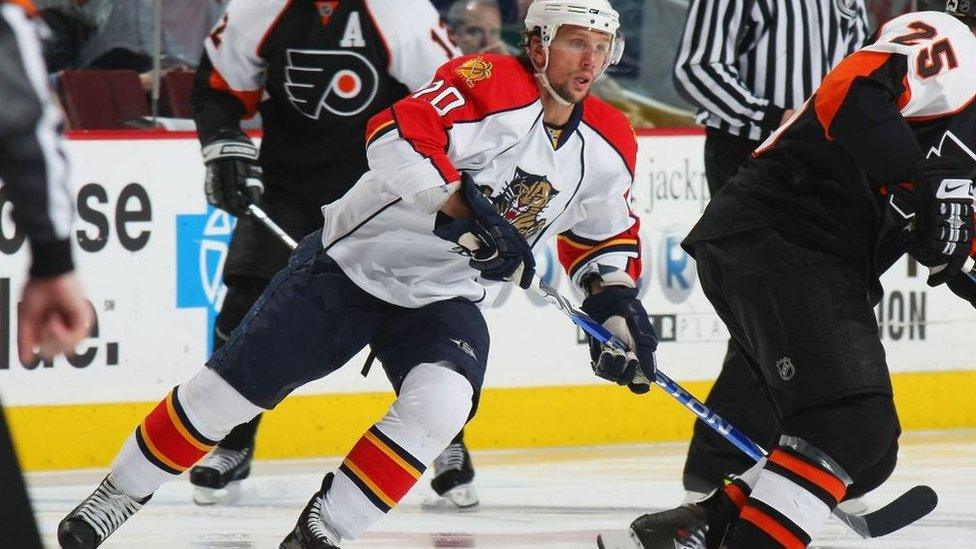After death of player Adam Johnson, how dangerous is ice hockey?
- Published

Players in Pittsburgh pay tribute to Johnson, a former NHL player
The tragic death of ice hockey player Adam Johnson after an injury on ice has renewed conversations about the sport's risks, and how players can be better protected.
Johnson, who played for the Nottingham Panthers, died after he was cut in the neck by a skate blade during a game on Saturday in Sheffield, UK. The team called the incident a "freak accident".
The 29-year-old from Minnesota was in his first season with the Panthers, after spending two seasons with the National Hockey League (NHL)'s Pittsburgh Penguins.
While a fatal injury on the ice is rare, this is not the first.
Teddy Balkind, a 10th-grade hockey player in Connecticut, died in January 2022 after he fell on ice and was cut on the neck, external by the skate blade of another player during a game.
Clint Malarchuk suffered a similar cut to the neck in 1989 - though he remarkably survived. During a National Hockey League (NHL) game, Malarchuk - then a goaltender for the Buffalo Sabers - experienced massive blood loss after a player's skate sliced his carotid artery and jugular vein.
In 2008, Richard Zednick, then of the Florida Panthers, also suffered a similar life-threatening cut and lived., external
The skate blade carries "the greatest risk" of catastrophic injury in ice hockey, said Nicole Chimera, an associate professor of kinesiology [the study of human body movement] at Brock University in Ontario.
It also introduces a unique danger that does not exist in other contact sports, like American football or rugby, said Prof Chimera.

Richard Zednik of the Florida Panthers survived a skate blade cut to the neck in 2008
Some of those injuries triggered calls for hockey leagues to make neck guards mandatory for protection during games, to minimize the risk of being cut.
In 2010, the Ontario Hockey Association ordered that all its players must wear neck guards, external after a player's throat was slashed by a skate blade during a game in Woodstock.
But these guards are not required by many other leagues, including the NHL.
"It is not at every level of hockey, and that is probably something we're going to see a renewed conversation about," Prof Chimera said.
On Monday, in the aftermath of Johnson's death, the English Ice Hockey Association (EIHA) said it would be mandatory to wear a neck guard during "all on-ice activities" from 2024 onwards.
Previously, players in the UK aged over 18 were allowed to play without them.
The Elite League, where Johnson played, has not announced a similar move, and some have spoken out about a stigma in ice hockey against the safety measure.
"If you've got a neck guard you're still seen as like a junior," Great Britain international Abbie Culshaw told BBC Newsbeat. She said players would "wind up" others for wearing a guard and "belittle" them.
"I hope for everyone's sake that what has happened has changed what people think," Culshaw said.

Injuries of the kind which killed Adam Johnson remain rare
While skate blade injuries can be catastrophic, ice hockey also carries the risk of serious spinal cord injuries or brain injuries, which can be fatal.
Study points to spinal injury risk
A 2020 US study in the Global Spine Journal, external found that the proportion of serious spinal cord injuries in hockey is high compared to other sports, due to its nature as a high-speed game with intentionally aggressive play.
"While American football receives the majority of attention regarding cervical spine injuries, ice hockey players are three times more likely to experience a cervical spine injury than American football players," the study suggests.
Most of those injuries happen during competition as opposed to practice, due to the intensity of gameplay.
The study adds that the risk of injury in the sport is only intensifying, as players are getting bigger, heavier and faster.
However, while hockey can lead to serious injuries, it still ranks behind sports like American football, soccer and basketball when it comes to the rate of overall injuries, according to 2022 data by the US National Safety Council., external
Prof Chimera said there are many positives that come with playing sports, including physical activity and the social benefits from being part of a team.
But she added it's important to recognise that the potential for serious injury is still there, as well as thinking about how to address it.
"I think we need to continue to consider what types of rule changes may need to come into play, and how to best protect athletes from the risk of that sports participation," she said.
- Attribution
- Published30 October 2023

- Published30 October 2023

- Published30 October 2023
